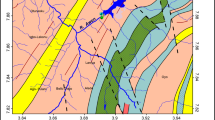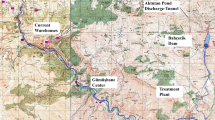Abstract
As drinking water quality determines the health and sanitation of any area, it is imperative to assess and monitor the water quality. Kathmandu University Drinking Water Supply Centre (aKUa) was established in 2017 with an aim to provide good quality and processed drinking water to different schools and associated offices of Kathmandu University (KU). The continuous monitoring of physico-chemical and biological water quality parameters was conducted before treatment (BLT) and after treatment (ALT) by the Aquatic Ecology Centre (AEC) of KU from the beginning of 2018 to the end of 2020. Physical parameters such as pH, dissolved oxygen, electrical conductivity, total dissolved solids, turbidity, and temperature were analyzed on a daily basis. Whereas, basic chemical parameters such as ammonia, nitrate, chloride, fluoride, total hardness, and calcium hardness along with biological parameters, total coliform and Escherichia coli were analyzed on a weekly basis. Moreover, heavy metals; iron, cadmium, manganese, and arsenic were analyzed on a yearly basis. From the data obtained by three years of continuous monitoring, the seasonal variation and monthly variation in physico-chemical and microbial parameters of before and after treatment samples were also analyzed. Also, results revealed the analyzed variables were comparable with the National Drinking Water Quality Standards, 2005 of the Government of Nepal and found to be within the permissible limit. Further, the significant difference in before treatment BLT and after treatment ALT was found in various physico-chemical as well as biological parameters. Moreover, Principal Component Analysis (PCA) revealed various principal components contributing to water quality in both BLT and ALT. In conclusion, water supplied by aKUa is suitable to use for drinking purposes. The continuous monitoring of water and effort from the concerned team is key for successful improvement and upkeep of the drinking water quality.





Similar content being viewed by others
References
APHA (2017) Standard Methods for the Examination of Water and Wastewater, 23rd Edition. American Public Health Association, American Water Works Association, Water Environment Federation
Briffa J, Sinagra E, Blundell R (2020) Heavy metal pollution in the environment and their toxicological effects on humans. Heliyon 6:e04691
Burlakoti N, Upadhyaya J, Ghimire N, Bajgai TR, Chhetri AB, Rawal DS, Koirala N, Pant BR (2020) Physical, chemical and microbiological characterization of processed drinking water in central Nepal: current state study. J Water Sanit Hyg Dev 10:157–165
Cabral JP (2010) Water microbiology. Bacterial pathogens and water. Int J Environ Res Public Health 7:3657–3703
Chen N, Hong H, Gao X (2021) Securing drinking water resources for a coastal city under global change: scientific and institutional perspectives. Ocean Coast Manag 207:104427
Chowdhury S, Mazumder MJ, Al-Attas O, Husain T (2016) Heavy metals in drinking water: occurrences, implications, and future needs in developing countries. Sci Total Environ 569:476–488
Cosgrove WJ, Loucks DP (2015) Water management: current and future challenges and research directions. Water Resour Res 51:4823–4839
Daniel D, Diener A, van de Vossenberg J, Bhatta M, Marks SJ (2020) Assessing drinking water quality at the point of collection and within household storage Containers in the Hilly Rural Areas of mid and far-Western Nepal. Int J Environ Res Public Health 17:2172
Deshwal J, Saharan J, Deshwal B (2016) A study on water quality parameters of drinking water of rural areas of Narwana, Haryana (India). Int J Curr Res 8:329–333
Dindarloo K, Ghaffari HR, Kheradpisheh Z, Alipour V, Ghanbarnejad A, Fakhri Y, Goodarzi B (2016) Drinking water quality: comparative study of tap water, drinking bottled water and point of use (PoU) treated water in Bandar-e-Abbas. Iran Desalin Water Treat 57:4487–4493
Fawell J, Bailey K, Chilton J, Dahi E, Magara Y (2006) Fluoride in drinking-water. IWA publishing, London
Ferré L (1995) Selection of components in principal component analysis: a comparison of methods. Comp Stat Data Anal 19:669–682
Gahan CS, Sundkvist JE, Dopson M, Sandström Å (2010) Effect of chloride on ferrous iron oxidation by a Leptospirillum ferriphilum-dominated chemostat culture. Biotechnol Bioeng 106:422–431
Kanduti D, Sterbenk P, Artnik B (2016) Fluoride: a review of use and effects on health. Materia Socio-Medica 28:133
Maharjan S, Joshi TP, Shrestha SM (2018) Poor quality of treated water in Kathmandu: comparison with Nepal drinking water quality standards. Tribhuvan University J Microbiol 5:83–88
Mahurpawar M (2015) Effects of heavy metals on human health. Int JRes Granthaalayah 3(9):2394–3629
Mohod CV, Dhote J (2013) Review of heavy metals in drinking water and their effect on human health. Int J Innov Res Sci Eng Technol 2:2992–2996
Pandey CL (2021) Managing urban water security: challenges and prospects in Nepal. Environ Dev Sustain 23:241–257
Parihar S, Ajit K, Ajay K, Gupta R, Manoj P, Archana S, Pandey A (2012) Physico-chemical and microbiological analysis of underground water in and around Gwalior city, MP, India. Res J Recent Sci 2277:62–65
Radfard M, Yunesian M, Nabizadeh R, Biglari H, Nazmara S, Hadi M, Yousefi N, Yousefi M, Abbasnia A, Mahvi AH (2018) Drinking water quality and arsenic health risk assessment in Sistan and Baluchestan, Southeastern Province. Iran Hum Ecol Risk AssessInt J 25:949–965
Rai S, Ono K, Yanagida J, Ishiyama-Imura S, Kurokawa M, Rai C (2012) A large-scale study of bacterial contamination of drinking water and its public health impact in Nepal. Nepal Med Coll J 14:234–240
Rufener S, Mäusezahl D, Mosler HJ, Weingartner R (2010) Quality of drinking-water at source and point-of-consumption—drinking cup as a high potential recontamination risk: a field study in Bolivia. J Health Popul Nutr 28(1):34–41
Sapkota S, Pradhan SP, Nicholson K, Neumann K, Sharma S (2019) Drinking water quality of Sagarmatha National Park, Nepal. In: Proceedings of International Conference on Natural Resources, Agriculture Society in Changing Climate, Kathmandu, Nepal, pp 146–160
Sharma S, Baidya M, Poudel P, Panthi SR, Pote-Shrestha RR, Ghimire A, Pradhan SP (2021) Drinking water status in Nepal: an overview in the context of climate change. J Water Sanit Hyg Dev 11(6):859–866
Tiwari PC, Tiwari A, Joshi B (2018) Urban growth in Himalaya: understanding the process and options for sustainable development. J Urban Reg Stud Contemp India 4:15–27
Udmale P, Ishidaira H, Thapa BR, Shakya NM (2016) The status of domestic water demand: supply deficit in the Kathmandu Valley. Nepal Water 8:196
UN-Water (2017) UN-Water Global Analysis and Assessment of Sanitation and Drinking-Water (GLAAS) 2017 report: Financing universal water, sanitation and hygiene under the Sustainable Development Goals. WHO Geneva
Upadhyay JP (2018) Higher Education in Nepal. Pravaha 24:96–108
Ward MH, DeKok TM, Levallois P, Brender J, Gulis G, Nolan BT, VanDerslice J (2005) Workgroup report: drinking-water nitrate and health—recent findings and research needs. Environ Health Perspect 113:1607–1614
Wasana HM, Perera GD, Gunawardena PDS, Fernando PS, Bandara J (2017) WHO water quality standards Vs Synergic effect (s) of fluoride, heavy metals and hardness in drinking water on kidney tissues. Sci Rep 7:1–6
WHO (2008) Guidelines for Drinking-water Quality. World Health Organization, Geneva
WHO/UNICEF (2017) Progress on Drinking Water, Sanitation and Hygiene: 2017 Update and SDG Baselines. World Health Organization and United Nations Children’s Fund, Geneva
Acknowledgements
Authors like to thank the physical facility of Kathmandu University and the regular staff of aKUa for their constant efforts to manage the water supply system. We are grateful to Mr. Shiwashish Singh Swar for providing the high-quality drone shoot image of Kathmandu University.
Funding
Not applicable.
Author information
Authors and Affiliations
Contributions
SPP; laboratory works, data analysis, and manuscript preparation, PJ; laboratory works, data analysis, and manuscript preparation, PP; laboratory works, data analysis, and manuscript preparation, AG; supervision and manuscript preparation SC; laboratory works, JM; data analysis, MP; data analysis and manuscript preparation, NK; laboratory works, AL; supervision of aKUa, BPP; supervision and manuscript preparation, RDTS; supervision and manuscript preparation, and SS; conceptualization of project and supervision.
Corresponding author
Ethics declarations
Conflict of interest
Authors declare no conflict of interest.
Ethical Approval
Not applicable.
Additional information
Publisher's Note
Springer Nature remains neutral with regard to jurisdictional claims in published maps and institutional affiliations.
Supplementary Information
Below is the link to the electronic supplementary material.
Rights and permissions
About this article
Cite this article
Pradhan, S.P., Joshi, P., Poudel, P. et al. Long-term assessment of water quality of Kathmandu University Drinking Water Supply Centre, Nepal. Sustain. Water Resour. Manag. 8, 41 (2022). https://doi.org/10.1007/s40899-022-00636-x
Received:
Accepted:
Published:
DOI: https://doi.org/10.1007/s40899-022-00636-x




